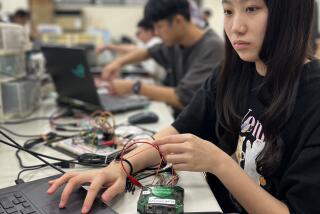U.S. hard-pressed to stem domestic R&D losses
Reporting from Washington — President Obama’s proposal to boost the research tax credit for businesses is widely seen as necessary to bolster American competitiveness in the global economy.
But even if the $100-billion plan is approved, it won’t begin to address the fundamental question of how to turn that research and new technology into jobs and renewed prosperity for Americans.
Over the last two decades, U.S. scientists and engineers have discovered or pioneered the science behind one blockbuster product after another — from flat-panel screens and robotics to the lithium batteries that run next-generation power tools and electric cars.
Yet in almost every case, production, jobs and most of the economic benefits that sprang from those breakthroughs have ended up overseas.
America’s innovative spirit may still be the envy of the world — major steps forward in nanotechnology and biomedical fields, among others, continue to be made in U.S. labs. But without more effective policies to translate those achievements into gains at home, the fruits of America’s creative genius will probably continue to be reaped by others.
And new reports show that during the recession American companies ramped up investment overseas for plants and new hires, as well as research and development — even as they cut back domestically.
Foreign subsidiaries of U.S. corporations increased their spending on research and development by more than 7% in 2008 from the previous year, pushing the total to nearly $37 billion. But these same multinational companies sliced R&D expenditures in the U.S. that year 2.2% to $199 billion, Commerce Department data showed.
A similar but less dramatic difference was evident in hiring: Employment at these overseas units rose 1% in 2008 — and a stunning 15% in China — but was down 2% for the U.S. elements of the 2,200 multinational firms the Commerce Department studied.
Some of these jobs were lost to automation, but Obama and many independent economists said a big factor was the sharply different policy approaches of U.S. and foreign governments.
For decades, Washington has taken a largely hands-off, or laissez faire, approach, sometimes even adopting tax and other policies that critics said actively encourage the movement of manufacturing and other business activity overseas.
By contrast, export giants such as Germany, Japan and South Korea have embraced government policies — and even pressure tactics — that push businesses to maintain operations at home.
“Other countries do a much better job,” said Robert Atkinson, president of the Information Technology and Innovation Foundation, a nonpartisan Washington think tank. “We’re pretty much the only country with the illusion that we’re not in competition with the rest of the world.”
Obama, as he announced a package of stimulus measures last week in a Cleveland suburb, sought to sound a populist, even nationalistic note:
“Instead of tax loopholes that incentivize investment in overseas jobs,” he said, “I’m proposing a more generous, permanent extension of the tax credit that goes to companies for all the research and innovation they do right here in Ohio, right here in the United States of America.”
Some corporate chiefs bristle at the notion that they are exploiting loopholes. Rather, they said, they are sending work overseas because it’s efficient and because otherwise they wouldn’t be able to compete. And many would argue that American innovation and entrepreneurism remain the envy of world.
But there’s little doubt that U.S. research investment has slipped from its once-preeminent position. By one common measure, private R&D spending as a share of economic output, the United States was No. 8 among developed countries in the latest tally by the Organization for Economic Cooperation and Development.
Washington’s funding for basic research, meanwhile, has been essentially flat since 2003, on an inflation-adjusted basis. The federal R&D budget for 2011 shows a decline, according to the National Science Foundation.
“This is the last trend one wants to see with global R&D spending continuing to grow rapidly,” said Gregory Tassey, senior economist at the National Institute of Standards and Technology, a federal agency promoting technology and industry.
Yet economists and business leaders worry that increasing support for U.S. laboratories and technology centers will not necessarily strengthen the economy.
The nation’s ability to turn ideas into products and profits at home has been eroded by manufacturing cuts so deep that entire supply chains have vanished, and with them skilled labor, component makers and specialized companies needed to bring scientific discoveries to market.
Examples include A123 Systems Inc. in Massachusetts. With government support, the company is building plants in Michigan to produce its breakthrough lithium-ion batteries for electric cars, but as a start-up it had little choice but to rely on the technical and manufacturing capabilities of China to crank out products quickly to show potential customers.
Even then, despite its MIT-born technology, A123 lost out to a South Korean company to supply batteries for General Motors Co.’s Chevy Volt.
Similarly, the technology behind silicon-based solar panels was originally developed in America. But even as the solar panel industry took off in countries such as Germany, where it was backed by strong government policies, the industry in the U.S. declined, partly because electronics manufacturing and other production capabilities had dried up years earlier.
“If you just do breakthrough R&D and in the end don’t make the stuff, that’s a losing argument,” said Ralph Gomory, a research professor at New York University and former head of research at IBM. He called it “the innovation delusion: We can design things; others will build them.”
Apple Inc. has perfected the trend, making a fortune selling snazzy products that are designed by legions of creative people in the U.S. but manufactured almost entirely in China. Analysts note that Apple captures the bulk of the profit while the U.S. economy loses little in giving up low value-added assembly operations to the Chinese.
But Apple’s case is rare. A lot of companies design things and try to hold on to the technology but eventually lose control over it in the process of using overseas manufacturers — or are beaten out by rivals who produce similar goods at cheaper prices.
So the decline of U.S. manufacturing has increasingly become an economic Achilles’ heel.
“When products are designed and manufactured side by side in America, businesses can discover new efficiencies and develop second-, third- and fourth-generation upgrades that simply would never occur in a cloistered research lab,” U.S. Commerce Secretary Gary Locke said in a speech early this year.
“When they are not, we allow other countries to develop new businesses and new jobs,” he added.
At least a handful of efforts are underway to create such self-reinforcing systems in the U.S., including tech areas in New York’s Hudson River Valley and in San Diego.
Forming similar clusters may be one way to compete against manufacturing powerhouses such as Germany and Japan, where government plays a much stronger role in driving research and pressing business leaders to focus on making and selling goods at home.
The question is whether these or other possible answers to the problem can be developed in the United States within the present ideological and policy framework, or whether more fundamental change would be required.
don.lee@latimes.com
More to Read
Inside the business of entertainment
The Wide Shot brings you news, analysis and insights on everything from streaming wars to production — and what it all means for the future.
You may occasionally receive promotional content from the Los Angeles Times.











